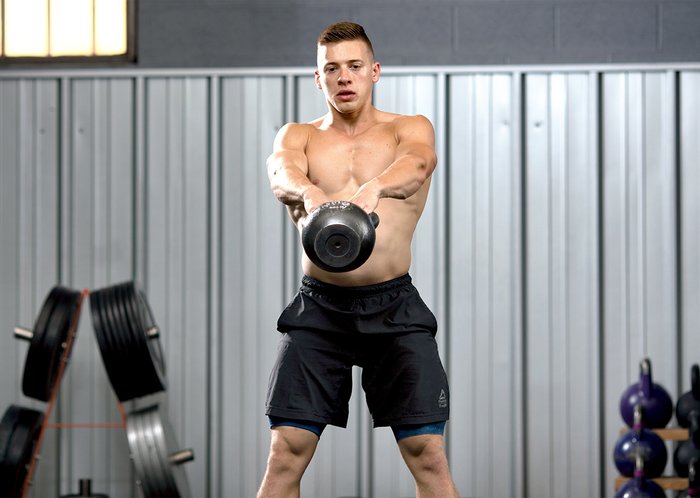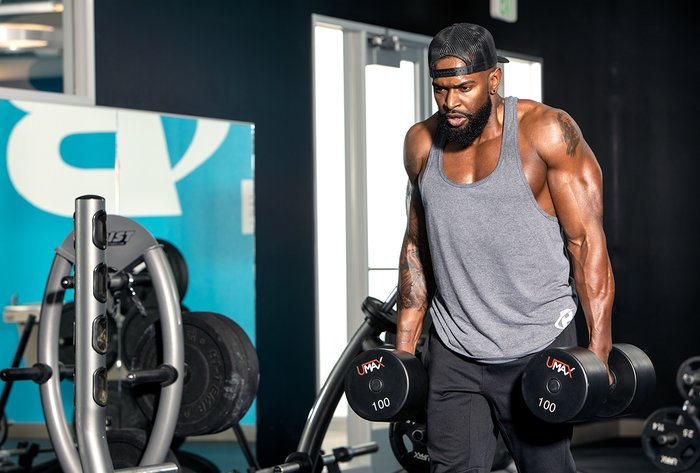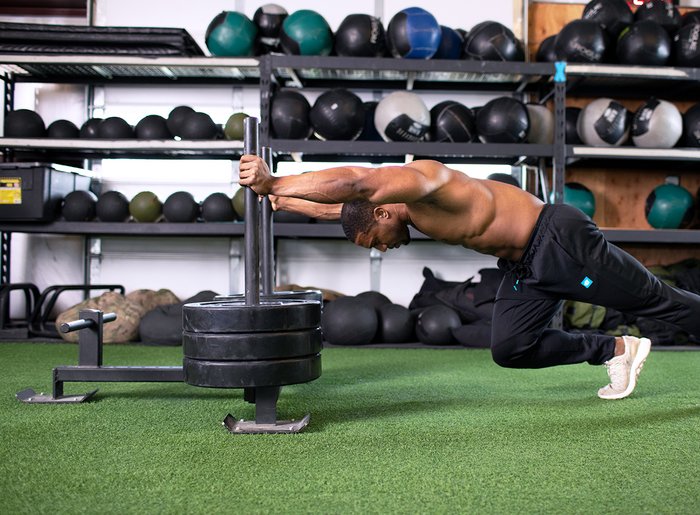It's time for the post-workout cardio you promised yourself you would add in. But 30 minutes on the treadmill sounds about as appealing as getting a root canal. So, you're left with two choices: Slog through it, or go home early knowing you shorted your training.
At JKConditioning, we are big fans of secret option number three: Replace that bland cardio routine with simple, sweaty conditioning work. Think of conditioning work as cardio for gym bros. You certainly won't be using a treadmill or elliptical for any of these challenging finishers! You'll do straightforward work, feel it from head to toe, and know you did something substantial.
1. Kettlebell Swing Intervals

The kettlebell swing is a fantastic conditioning tool, and a favorite with our clients. Yes, some people experience some lower back discomfort with swings at first, but this can usually be remedied with some form correction. Here are the basics:
- Set up with a hip-width stance and grab the bell with an overhand grip.
- Hinge at the hip (don't squat) and rock the bell slightly backward to build some momentum. Pull it up between your legs (don't worry, you won't damage anything).
- Forcefully thrust your hips forward, similar to locking out a deadlift.
- As your hips come forward, your arms should float upward to bellybutton or chest level, carrying the bell with them. The timing here is key. If the hip extension is out of sync with the movement of the arms, the bell will not go very high.
- Get tall at the top, but not leaning back into the lower back. Control the height of the bell with your arms. It doesn't need to go higher than your arms being parallel to the ground.
Swings lend themselves well to a time-based approach. Nobody wants to count reps on this explosive move! For a killer conditioning finisher, set an interval timer for a 20-second work period and 40-second rest period. Swing for 20, rest 40, and complete 10 rounds.
2. Rowing Machine Sprints
The rowing machine is easily the most challenging piece of cardio equipment in the gym. It's easy to tell because if you walk into any large commercial gym, the treadmills and ellipticals are always full, and the rowers are gathering dust. Consider this an endorsement! A well-made rower demands you use both the arms and legs intensively, creating a unique challenge for the body that few other cardio machines can match.
We like distance intervals with the rower as opposed to timed intervals. Get creative with these! Too much routine goes hand in hand with boredom, and boredom is definitely an issue that many people face when it comes to cardio.
To get started, try 10 sprints of 100 meters. Don't worry, the machine will do the counting for you! Rest the same amount of time it took you to complete the sprint. You will likely start out doing these in 20 seconds or less, but the times will quickly creep up as you proceed through the sets.
3. Loaded Carries for Distance
Loaded carries are a classic conditioning tool and can be done in many different ways. The most common variation is the farmer's carry. With this carry, you simply grab one or two heavy dumbbells, hold them at your sides with you arms extended and your shoulders rolled back, and walk. This can also be done with a trap bar if you have the space.

Other, less frequently used carries include:
- Zercher carry: The bar is held in the crease of your elbow. (An EZ-bar can work well for this.)
- Overhead carry: Dumbbells or a plate are held overhead with full arm lockout.
- Yoke carry: A specialized rig called a yoke is held across the shoulders.
For any variation of loaded carry, you can program it for time or distance. But given how a gym is usually a fixed space, time is a great place to start.
For time, start with 30 seconds of carrying followed by 60 seconds of rest, and complete 8 rounds. If you are going for distance, try 10 rounds of 20 yards (or thereabouts) with 45-60 seconds of rest between each round.
4. Fan Bike Sprints
Chances are, if anything on this list is going to make you lose your lunch, this is it. No matter if you call it a fan bike, AirDyne, or Assault Bike, this is a cruel piece of equipment. If the rowers are gathering dust at your local gym, the fan bike has cobwebs growing on it.
What's so good and bad about it? We detailed it in the article "The Misery Machine: 4 Brutal Fan-Bike Workouts," but the short version is that the resistance on this bike is provided by a giant fan, so the harder you push yourself, the harder this piece of equipment is going to push back.
The fan bike usually comes equipped with two great interval options programmed into the bike's software. The first is a 10/20 Tabata-style interval: 10 seconds of sprinting followed by 20 seconds of rest for 8 total rounds. Can't go wrong with that.
For the brave, the bike also has a 20/10 interval, also for 8 total rounds. If you are feeling ambitious, give that one a try.
I know what you may be thinking: "Only 4 minutes? That's nothing." Be warned though: There is a reason this bike is a favorite among CrossFitters. Your lungs will burn, and no amount of water will help. And your legs will be ready to explode from acid and lactate accumulation. Enjoy!
5. Sled Pushes
There is a reason that human beings invented the wheel: It clearly makes it easier to move heavy loads over distances. If you want a challenging conditioning workout, though, easy is your enemy. That's why you are going to drop the wheels, embrace your inner ox, and push a heavy sled.

Sled pushes will not only make your lungs burn, they will strengthen your glutes, hamstrings, and calves better than most other exercises—all without the joint stress of heavy deads or squats.
The set-up for the push is simple:
- Load up a sled with some weights. When loading the sled, be conscious of the surface you will be pushing on. The amount of friction makes a big difference. Pushing on grass turf is much easier than pushing on conventional rubber gym flooring or parking lot asphalt.
- Get low, and keep your chest puffed out. You can push with your arms extended or get closer to the sled by bending your arms—whatever feels best.
- Start pushing, focusing on bringing your knees high and digging your feet into the floor to generate a powerful push each time.
Similar to the loaded carry, you can program the sled push for time or distance. For distance, try a 30-yard push followed by 45-60 seconds of rest and complete 10 rounds. For time, try a 30-second push followed by a 60-second rest for 8 rounds.
Feel the Good Pain
The workouts above all have two things in common: They will make you question your choices while you're doing them, but also keep you seriously focused and engaged on the task at hand. You can't say that about "normal" cardio!
If you do find yourself getting accustomed to these though, try combining them! You could do kettlebell swings alternated with loaded carries, rower sprints with loaded carries, sled pushes with kettlebell swings, and many other combos. Be creative with it to make sure you don't get bored, bro!
For a great all-around fitness program that combines conditioning, strength, and mobility, jump on Total Fitness with Andy Speer, available only on Bodybuilding.com BodyFit Elite.

